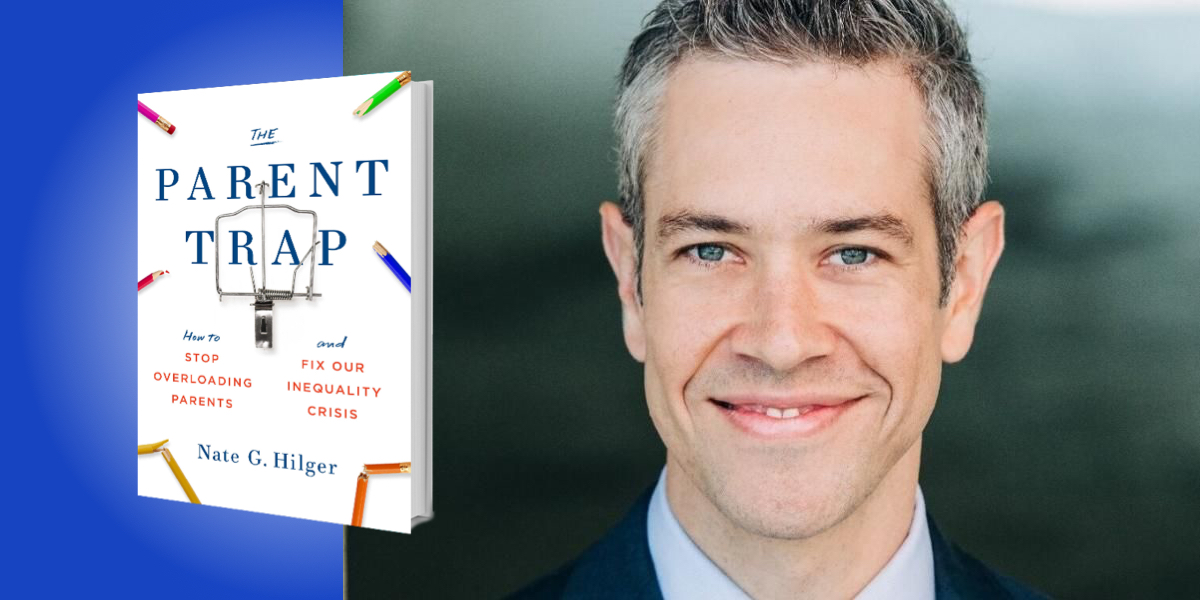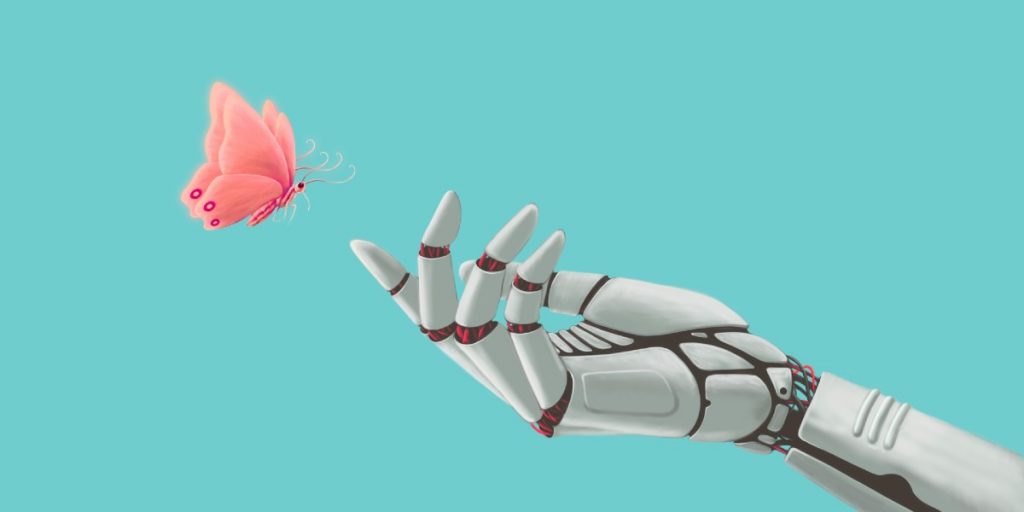Nate Hilger is a data scientist for the Chan Zuckerberg Initiative, former economics professor at Brown University, and a dad.
Below, Nate shares 5 key insights from his new book, The Parent Trap: How to Stop Overloading Parents and Fix Our Inequality Crisis. Listen to the audio version—read by Nate himself—in the Next Big Idea App.
1. Parenting involves two very different kinds of jobs.
We think parenting involves one job: raising kids. But really, parents have two jobs which are completely different from each other.
One job is to care for children. Caring is about loving and “being there” for our kids. It’s about doing our best to share what brings us joy and meaning in life, whether that’s faith or music, food or football. Most parents are awesome at caring for their children, and they know it.
The second job is to build skills in children. This is the more clinical, professional side of parenting. In order for kids to thrive in adulthood they have to build a lot of skills—literacy, numeracy, critical thinking, conflict resolution, tenacity, discipline, and so many more. Managing skill growth is no easy task. It is not something most parents can do effectively on their own, in spare time, on a budget.
“Rely on professionals.”
But that’s ok, because when it comes to hard, complicated, expensive tasks like child skill development, we have a ready-made solution: rely on professionals. This is what rich parents already do by providing kids with teachers, tutors, coaches, and counselors starting early in life. We just need to make this strategy accessible to regular families.
2. Supporting parents can solve our deepest inequality problems.
There was a remarkable woman named Cora Hillis who grew up in Iowa before World War I. Early in Hillis’s life, her little sister contracted a spinal disease and doctors diagnosed her as a lost cause. But under Hillis’s care, her sister lived a healthy, productive life well into her mid-30s—proving all the physicians wrong.
Later, Cora Hillis became a mother and lost three of her five children to illnesses that doctors had no way to treat. After the third death—and almost a fourth!—Hillis fell into a deep depression, but she recovered to pursue what became her life’s consuming vision. Hillis believed that scientists weren’t taking child development seriously, especially compared to the scientific revolution overtaking agriculture. Agricultural research stations had sprung up everywhere to help farmers raise healthier crops and livestock. Why, asked Hillis, weren’t we investing in similar research stations to understand human development? She brought her proposal to one powerful man after another, each time facing rejection or ridicule. She persevered and ultimately triumphed, creating the world’s first research institute devoted to children: the Iowa Child Welfare Research Station.
Through an improbable chain of discoveries, the Iowa Station inspired some of the most important research of the 20th century. This research showed that working class and lower-income kids didn’t have to reach adulthood so far behind richer kids, if only the public was willing to invest in giving parents access to more learning opportunities for their children.
3. Inequality arises from opportunity gaps outside of school.
Children only spend 10% of their time from birth through age 18 in public school. Public school doesn’t start until age five, then it’s only in session about half of all days each year due to seasonal breaks and weekends, and even then, only for about 7 hours per day. Added up, it’s 10% of time.
That tiny sliver of time in school is actually, by far, the most equal part of childhood. The public school spending gap between rich and poor kids today is only 2%. At home, where kids spend 90% of childhood, the spending gap between rich and poor kids is over 1,500%.
“We all showed up at school, sat in the same classrooms, and pretended we were all playing the same game.”
This kind of gap feels very real to me, because I remember watching it up close. When I was a kid in Orange County, California I was fortunate to attend very diverse public schools. How kids lived outside of school seemed like this elephant standing in the middle of the classroom. The richer kids seemed calmer and healthier. They seemed better at stuff, and for good reason—they had private tutoring, test prep, sports clubs, music lessons, libraries, and computers. They went to expensive summer camps and recharged in Tahoe or Hawaii over spring break. But every morning we all showed up at school, sat in the same classrooms, and pretended we were all playing the same game.
The reality is that we should be more concerned about leveling the playing field during the 90% of the time children aren’t in school, rather than fixating on comparably minor inequalities that persist in our K-12 public school system. It all comes down to making things easier for parents by providing resources to secure their children’s well-being and success.
4. Our society has a giant missing institution.
If the reality is that most parents (on their own) can’t set up children for success, then our society is missing an institution. That institution is something we might call Familycare. It would be like Medicare, except instead of helping those over age 65 get professional support to address health care problems, Familycare would help families get professional support to address child development problems.
Professional help wouldn’t mean some scary government takeover of our kids. It would mean greater access to trusted local experts such as tutors, teachers, counselors, coaches, and nurses. People with training and experience from our own local communities. People who rich parents already rely on to help their children get ahead.
Familycare would be different from Medicare in one key way. Whereas Medicare is our nation’s single biggest financial liability, Familycare would pay for itself. Like it or not, we’re all shareholders in each other’s children. If you pay for public programs that help my children build more skill, my children will grow up to earn more income, and you will keep a third of that new income in the form of tax revenue. My successful child will fund the public goods and services that you rely on: roads, public schools, hospitals, the military that protects our nation, publicly-funded research that fuels innovation. Our failure to enact a program like Familycare is like failing to fix a flat tire—it’s self-sabotage on a grand scale.
You might worry that government would screw up Familycare. I call that the Myth of Government Failure. Most of our big, publicly-funded efforts to help children have worked wonders, but these success stories have been obscured by bad data and flawed statistics. Fortunately, new research has begun to dispel this fog and paint a more balanced picture of what these public programs have accomplished.
5. Parents need an organization like the AARP.
To secure a major program like Familycare, parents need more political power. For that to happen, some things have to change.
“For many kids, Familycare would mean the difference between a life of fear and a life of freedom.”
First, more parents need to recognize how much we’re losing from the status quo. We can’t delude ourselves into thinking “well, most kids turn out all right” or “hey, my kid goes to a good school so she’s all set.” These are traps. Millions of children are missing out on big opportunities and losing hundreds of thousands of dollars in future income. For many kids, Familycare would mean the difference between a life of fear and a life of freedom.
Once parents recognize their enormous shared interests, we have to organize. Here the missing link is clear: parents need an organization like the American Association of Retired People. The AARP has nearly 40 million members. People join because it offers discounts on stuff like restaurants, movies, and health care. This bipartisan, mass-membership foundation empowers the AARP to protect Social Security and Medicare and assure that all people over 65 get the dignity and support that they deserve.
There is no bipartisan, mass-membership organization like the AARP for families, and there should be. Call it the American Association of Parents and Guardians—the AAPG. The AAPG would offer great discounts on things that parents need—diapers, cribs, vacations, everything. It would recruit people starting from pregnancy. It would reach out to parents through physicians, pediatricians, churches, child care centers, playgrounds and grocery stores.
By tapping into our dormant political power this way, parents can open the door to a program like Familycare, and assure that their children get the support to thrive independently as adults, to become the leaders, scientists, artists, engineers, teachers, workers, entrepreneurs, parents, partners, and citizens that will catapult our country onto a better trajectory for everyone.
To listen to the audio version read by author Nate Hilger, download the Next Big Idea App today:
































